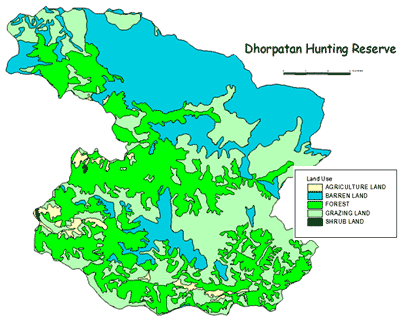 Besides
national parks and wildlife reserves His Majesty's
Government of Nepal has also set aside a hunting
reserve at Dhorpatan where controlled hunting
of some species is allowed. Covering an area
of 1,325 sq. km., the reserve is situated on
the southern flanks of Mt. Dhaulangiri I (8,167
m.) in districts of Rukum, Baglung and Myagdi
in western Nepal.
Besides
national parks and wildlife reserves His Majesty's
Government of Nepal has also set aside a hunting
reserve at Dhorpatan where controlled hunting
of some species is allowed. Covering an area
of 1,325 sq. km., the reserve is situated on
the southern flanks of Mt. Dhaulangiri I (8,167
m.) in districts of Rukum, Baglung and Myagdi
in western Nepal.
The area's vegetation is characterised
by well-developed mixed-hardwood forest at lower
elevation and many plant species of drier climate
to the north. Tree species include fir, pine,
birch, rhododendron, hemlock, oak, juniper and
spruce. As in many other protected environments
of Nepal, the reserve includes several villages
inhabited by hill tribes as well as people of
Tibetan descent who supplement farming with
trade and animal husbandry. The reserve is one
of the prime habitats of blue sheep, a highly
prized trophy animal, which is the main target
of hunters. Other game species are ghoral, serow,
Himalayan tahr, black bear, pheasant and partridge.
Endangered species of the area include the red
panda and cheer pheasant. Controlled hunting
is allowed with proper licence and certain seasons
of the year. Game licence is issued by the Department
of National Parks and Wildlife Conservation
in Kathmandu and there are a few hunting outfitters
who can make arrangements for expeditions. Besides
hunting, Dhorpatan is also an attractive destination
for the trekkers and wildlife enthusiasts as
protection has enabled animal numbers to increase
in this rarely visited area.
FEATURES
The higher elevations remain snow-capped throughout
the year. Altitudes vary from 3000 m to more
than 7000 m. The flat meadows above tree line
(4000 m), locally known as “patans”,
are important for wild animals like the blue
sheep and other herbivores. The Reserve is divided
into seven six blocks for hunting purposes.
The Reserve is surrounded by villages on all
sides except the north.
CLIMATES
The monsoon lasts until the end of November.
Day time temperatures are very low during winter
due to strong winds. Higher elevations remain
covered with cloud in the morning; later clouds
are cleared by the wind. Snow may occur even
at low elevation until early April, however,
it soon melts. The best time to visit the Reserve
is March to April.
FLORA
The Reserve is characterized by alpine, sub-alpine
and high temperate vegetation. Common plant
species include fir, pine, and birch, rhododendron,
hemlock, oak, juniper and spruce. Pastureland
occupies more than 50 % of the area of the Reserve
at higher elevation.
FAUNA
The Reserve is one of the prime habitats for
blue sheep, a highly coveted trophy. Other animals
found here include: leopard, goral, serow, Himalayan
tahr, Himalayan black bear, barking deer, wild
boar, rhesus macaque, langur and mouse hare.
Pheasants and partridge are common and their
viable population in the reserve permits controlled
hunting. Endangered animals in the Reserve include:
musk deer, wolf, red panda, cheer pheasant and
danphe. The hunting license is issued by the
Department of National Parks and Wildlife Conservation.
PLACES OF INTEREST
“Dhorbaraha” a famous Hindu pilgrimage
site lies on the banks of Uttarganga River near
Dhorpatan within the Fagune block. Every year
on the day of "Janai Purnima" in August,
a religious fair is held here which is attended
by many local devotees. The magnificent view
of Dhaulagiri himal from Barse, Dogari and Gustung
blocks are exceptional, where as Seng and Sundaha
block are rich in wild animals.
FACILITIES
Local people are allowed to collect limited
quantities of fuel-wood for their daily use.
Visitors are requested to be self-sufficient
with fuel (Kerosene) before entering the Reserve.
Since no medical facilities are available in
and around the Reserve, it is suggested that
visitors carry a comprehensive first-aid kit
including medicines for intestinal disorders.
Two hotels/lodges catering modest Nepali cuisine
are located at Chhyantung, near Dhorpatan.
HOW TO GET THERE
Public bus service is available from Kathmandu
to Tansen-Tamgash Gulmi from where the Reserve
HQ is a three-day walk via Burtibang.
Air service is available to Pokhara,
from where public buses are available for Baglung.
The Reserve HQ can be reached in 4 days walk
from Baglung. Now direct buses are available
from Kathmandu to Baglung.
Chartered helicopter services
available on request from Kathmandu.